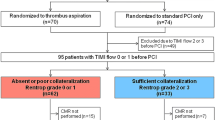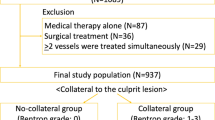Abstract
The spontaneous recruitment of acute coronary collaterals in the setting of an ST elevation myocardial infarction (STEMI) is seen frequently in those patients undergoing primary percutaneous coronary intervention (pPCI) and is associated with improved clinical outcomes. However, it is unknown whether in patients who present with a recurrent STEMI, the degree of collateral recruitment remains the same as in the index procedure. We reviewed all patients presenting to our tertiary centre with a STEMI undergoing primary or rescue percutaneous coronary intervention (PCI) from July 2010 until December 2018. We identified patients who presented with a recurrent STEMI following their index procedure. We defined patients with poor collateral recruitment as Rentrop grade 0 or 1, whilst patients with robust collateral recruitment as Rentrop grade 2 or 3. Of the 1795 patients who were identified, there were 27 cases in 25 patients who presented with a repeat STEMI following their index procedure. The median time between cases was 12.8 days (IQR 2.3–589.5 days). Compared to the index case, there was no statistically significant difference in the degree of collateral recruitment in recurrent presentations (Z = − 0.378, p = 0.70). In those patients presenting more than 6 months following the index procedure, the median time between cases was 654.5 days (IQR 479.5–1151.9). There was no difference in the degree of collateral recruitment in recurrent presentations (Z = 0.000, p = 1.0). Cases which had poorer collateral recruitment in recurrent presentations were less likely to be current smokers (0% vs 50%, p < 0.001) and less likely to have diabetes (0% vs 27.3%, p < 0.05) The recruitment of spontaneous coronary collaterals remains constant in recurrent STEMI presentations suggesting an innate biological process rather than merely a manifestation of alteration of haemodynamic blood flow. Further investigations to identify these processes is required.



Similar content being viewed by others
References
Pitt B (1959) Interarterial coronary anastomoses. Occurrence in normal hearts and in certain pathologic conditions. Circulation 20:816–822
Meier P, Hemingway H, Lansky AJ, Knapp G, Pitt B, Seiler C (2012) The impact of the coronary collateral circulation on mortality: a meta-analysis. Eur Heart J 33(5):614–621
Perez-Castellano N, Garcia EJ, Abeytua M, Soriano J, Serrano JA, Elizaga J, Botas J, Lopez-Sendon JL, Delcan JL (1998) Influence of collateral circulation on in-hospital death from anterior acute myocardial infarction. J Am Coll Cardiol 31(3):512–518
Sen O, Allahverdiyev S, Topuz M, Baykan AO, Oz F, Koc M (2017) Clinical significance and determinants of prompt recruitment collaterals during primary percutaneous coronary intervention. Kardiol Pol 75(8):763–769
Wang B, Han YL, Li Y, Jing QM, Wang SL, Ma YY, Wang G, Luan B, Wang XZ (2011) Coronary collateral circulation: effects on outcomes of acute anterior myocardial infarction after primary percutaneous coronary intervention. J Geriatr Cardiol 8(2):93–98
Yaylak B, Altintas B, Ede H, Baysal E, Akyuz S, Bilge O, Sevuk U, Erdogan G, Ciftci H (2015) Impact of coronary collateral circulation on in-hospital death in patients with inferior ST elevation myocardial infarction. Cardiol Res Pract 2015:242686
Hara M, Sakata Y, Nakatani D, Suna S, Nishino M, Sato H, Kitamura T, Nanto S, Hori M, Komuro I, Investigators O (2016) Impact of coronary collaterals on in-hospital and 5-year mortality after ST-elevation myocardial infarction in the contemporary percutaneous coronary intervention era: a prospective observational study. BMJ Open 6(7):e011105
Hernandez-Perez FJ, Goirigolzarri-Artaza J, Restrepo-Cordoba MA, Garcia-Touchard A, Oteo-Dominguez JF, Silva-Melchor L, Fernandez-Diaz JA, Dominguez-Puente JR, Alonso-Pulpon L, Goicolea-Ruigomez J (2017) Impact of coronary collaterals on long-term prognosis in patients treated with primary angioplasty. Rev Esp Cardiol (Engl Ed) 70(3):178–185
Kurtul A, Ozturk S (2017) Prognostic value of coronary collaterals in patients with acute coronary syndromes. Coron Artery Dis 28(5):406–412
Rechcinski T, Jasinska A, Peruga JZ, Forys J, Krzeminska-Pakula M, Bednarkiewicz Z, Trzos E, Kasprzak JD (2013) Presence of coronary collaterals in ST-elevation myocardial infarction patients does not affect long-term outcome. Pol Arch Med Wewn 123(1–2):29–37
Sorajja P, Gersh BJ, Mehran R, Lansky AJ, Krucoff MW, Webb J, Cox DA, Brodie BR, Stone GW (2007) Impact of collateral flow on myocardial reperfusion and infarct size in patients undergoing primary angioplasty for acute myocardial infarction. Am Heart J 154(2):379–384
Wustmann K, Zbinden S, Windecker S, Meier B, Seiler C (2003) Is there functional collateral flow during vascular occlusion in angiographically normal coronary arteries? Circulation 107(17):2213–2220
Holmes DR Jr, Kereiakes DJ, Garg S, Serruys PW, Dehmer GJ, Ellis SG, Williams DO, Kimura T, Moliterno DJ (2010) Stent thrombosis. J Am Coll Cardiol 56(17):1357–1365
Rentrop KP, Cohen M, Blanke H, Phillips RA (1985) Changes in collateral channel filling immediately after controlled coronary artery occlusion by an angioplasty balloon in human subjects. J Am Coll Cardiol 5(3):587–592
Antoniucci D, Valenti R, Moschi G, Migliorini A, Trapani M, Santoro GM, Bolognese L, Cerisano G, Buonamici P, Dovellini EV (2002) Relation between preintervention angiographic evidence of coronary collateral circulation and clinical and angiographic outcomes after primary angioplasty or stenting for acute myocardial infarction. Am J Cardiol 89(2):121–125
Desch S, de Waha S, Eitel I, Koch A, Gutberlet M, Schuler G, Thiele H (2010) Effect of coronary collaterals on long-term prognosis in patients undergoing primary angioplasty for acute ST-elevation myocardial infarction. Am J Cardiol 106(5):605–611
Kim EK, Choi JH, Song YB, Hahn JY, Chang SA, Park SJ, Lee SC, Choi SH, Choe YH, Park SW, Gwon HC (2016) A protective role of early collateral blood flow in patients with ST-segment elevation myocardial infarction. Am Heart J 171(1):56–63
Shen Y, Wu F, Pan C, Zhu T, Zhang Q, Zhang R, Ding F, Lu L, Hu J, Yang Z, Shen W, Wu Z (2014) Clinical relevance of angiographic coronary collaterals during primary coronary intervention for acute ST-elevation myocardial infarction. Chin Med J (Engl) 127(1):66–71
Werner GS, Ferrari M, Heinke S, Kuethe F, Surber R, Richartz BM, Figulla HR (2003) Angiographic assessment of collateral connections in comparison with invasively determined collateral function in chronic coronary occlusions. Circulation 107(15):1972–1977
Lee JH, Kim CY, Kim N, Jang SY, Bae MH, Yang DH, Cho Y, Chae SC, Park HS (2017) Coronary collaterals function and clinical outcome between patients with acute and chronic total occlusion. JACC Cardiovasc Interv 10(6):585–593
Werner GS, Emig U, Mutschke O, Schwarz G, Bahrmann P, Figulla HR (2003) Regression of collateral function after recanalization of chronic total coronary occlusions: a serial assessment by intracoronary pressure and Doppler recordings. Circulation 108(23):2877–2882
Kurotobi T, Sato H, Kinjo K, Nakatani D, Mizuno H, Shimizu M, Imai K, Hirayama A, Kodama K, Hori M, Group O (2004) Reduced collateral circulation to the infarct-related artery in elderly patients with acute myocardial infarction. J Am Coll Cardiol 44(1):28–34
Brugaletta S, Martin-Yuste V, Padro T, Alvarez-Contreras L, Gomez-Lara J, Garcia-Garcia HM, Cola C, Liuzzo G, Masotti M, Crea F, Badimon L, Serruys PW, Sabate M (2012) Endothelial and smooth muscle cells dysfunction distal to recanalized chronic total coronary occlusions and the relationship with the collateral connection grade. JACC Cardiovasc Interv 5(2):170–178
Conway EM, Collen D, Carmeliet P (2001) Molecular mechanisms of blood vessel growth. Cardiovasc Res 49(3):507–521
van Royen N, Piek JJ, Buschmann I, Hoefer I, Voskuil M, Schaper W (2001) Stimulation of arteriogenesis; a new concept for the treatment of arterial occlusive disease. Cardiovasc Res 49(3):543–553
Koerselman J, de Jaegere PP, Verhaar MC, Grobbee DE, van der Graaf Y, Group SS (2007) Coronary collateral circulation: the effects of smoking and alcohol. Atherosclerosis 191(1):191–198
Burke A, Fitzgerald GA (2003) Oxidative stress and smoking-induced vascular injury. Prog Cardiovasc Dis 46(1):79–90
Allahwala UK, Murphy JC, Nelson GI, Bhindi R (2013) Absence of a ‘smoker’s paradox’ in field triaged ST-elevation myocardial infarction patients undergoing percutaneous coronary intervention. Cardiovasc Revasc Med 14(4):213–217
Melidonis A, Tournis S, Kouvaras G, Baltaretsou E, Hadanis S, Hajissavas I, Tsatsoulis A, Foussas S (1999) Comparison of coronary collateral circulation in diabetic and nondiabetic patients suffering from coronary artery disease. Clin Cardiol 22(7):465–471
Meier P, Zbinden R, Togni M, Wenaweser P, Windecker S, Meier B, Seiler C (2007) Coronary collateral function long after drug-eluting stent implantation. J Am Coll Cardiol 49(1):15–20
Author information
Authors and Affiliations
Corresponding author
Ethics declarations
Conflicts of interest
All authors declare that they have no conflict of interest.
Additional information
Publisher's Note
Springer Nature remains neutral with regard to jurisdictional claims in published maps and institutional affiliations.
Rights and permissions
About this article
Cite this article
Allahwala, U.K., Weaver, J.C. & Bhindi, R. Spontaneous coronary collateral recruitment in patients with recurrent ST elevation myocardial infarction (STEMI). Heart Vessels 35, 291–296 (2020). https://doi.org/10.1007/s00380-019-01493-z
Received:
Accepted:
Published:
Issue Date:
DOI: https://doi.org/10.1007/s00380-019-01493-z




